To: The Impact Readers

May 2019 – The Rhodium Group published Capturing Leadership: Policies for the US to Advance Direct Air Capture Technology, which projected that global emissions need to reach net-zero between 2045 and 2055 to limit global temperature rise to 1.5 degrees Celsius.
March 2020 – The Department of Energy (DOE) announced $22 million for supporting research on direct air capture.
May 2020 – The Treasury Department and the Internal Revenue Service issued proposed regulations to help businesses understand how legislation passed in 2018 may benefit those claiming carbon capture credits.
Direct air capture technology is commercially ready for deployment. Companies have proposed at least 30 carbon capture projects to date. There are hundreds of millions of dollars of investment ready to deploy and commercialize direct air capture technology. However, deployment will only occur with federal policy action both in the near and long-term.
Up until now, there were little to no financial incentives to capture carbon emissions. Companies can now receive up to $50/ton of carbon captured and permanently stored underground. Projects can now start, and the sooner the better – previous research from the Rhodium Group found that 689 – 2,260 million tons of capture capacity is necessary to achieve net-zero emissions by 2050. Additionally, these projects need to begin construction before 2024 to claim the tax credit. In the current circumstances, it is unclear how many carbon capture projects will get built.
Regardless, start on the path to reach net-zero emissions, we need to start efforts to construct direct air capture projects. Not only do these projects have environmental impact, but they will also help create more jobs in the economy.
Sign up for The Impact and learn the perspectives behind the latest sustainability trends


Oatly just raised $200 million at a $2 billion valuation, effective selling a 10% stake in the company. The Blackstone Group led the round of fundraising, along with other backers – Howard Schultz, Oprah Winfrey, Roc Nation, Natalie Portman, Orkila Capital, and Rabo Corporate Investments. There is speculation that Oatly will be moving towards an initial public offering within the next 12 to 18 months.
Why does this matter?
A 2018 University of Oxford study has shown that milk alternatives are better use of resources than for dairy. The production of Oatly’s oat milk results in 80% lower green house gas emissions and 60% less energy use compared to cow’s milk. The Oxford study goes so far to specify that oat milk has the least environmental impact, compared to other alternative milks, in terms of emissions, land use, and water use.
Oatly’s valuation forecasts the growing popularity of plant-based foods. Consumers are more mindful of which products they purchase and consume, opting for healthier and more eco-friendly products. Beyond Meat is one company to refer to, as they went public last year (NASDAQ: BYND). The company went public at $25 per share, hit an all-time high of $222 and is now around $130.
What’s next?
Sales of plant-based foods that replace animal products have grown 29% in the past two years to $5 billion. Plant-based milk represents $2 billion of those sales, and has experienced a 14% growth in sales over the last two years. As oat milk is more environmentally friendly than almond milk, which drove the most sales in 2019, this investment will accelerate oat milk’s growth into the market.
Plant-based milk is only one growing corner of the plant-based food market. Consumer awareness will only continue to accelerate the plant-based food market, and even other markets, such as electronics.

The nationally covered blackouts in The Bay Area last year was a pivotal point for accelerating policy & enabling battery storage to become a surging purchase in 2020.
Most people in the San Francisco region that were affected are pushing to have their systems up and running by utilizing Tesla Powerwalls and pairing it with solar. Driving sales for companies like Sunrun and local installers up due to heavily increased demand. This adds complexity but additional resilience to the grid with a distributed set of energy resources and generators to tap into across the US – hence Sunrun has moved to partner with companies like Autogrid to develop VPP and Demand Response programs with their system.
It’s great for the utilities and policy makers due to the fact consumers are opting for a more expensive energy storage system as opposed to a standby generator.
This energy storage boom naturally begs the question of –
How will policy makers and utilities actually adapt to make energy storage a worthwhile investment for individuals
Well as a starting point – FERC just had Order 841 upheld in court this Friday. This allows regional operators to form wholesale markets for energy storage with systems as small as 100 kWh. This is huge as now that additional capacity that is unlocked across the grid enables for battery systems to communicate and share stored power with local microgrids.
The resulting incentives and financial support that will be created in deregulated markets for electric retailers is going to be ridiculous. In a good way of course. With the potential for wholesale markets forming the cost of deploying or implementing energy storage at every property being built will drop precipitously.
This likely means we will see EVEN BIGGER grid scale batteries
This is something already happening, especially in San Diego – which has a monopoly on the biggest battery banks today.
LS Power the grid infrastructure focused Private Equity firm has built two of the biggest batteries in San Diego. Just last month they turned on the biggest one at 62.5 MWh of capacity.
The biggest system before this was built by LS Power for their 40 MW Vista project. However, with new incentives and increased demand from PG&E and other utilities throughout California will drive even bigger batteries to be deployed in order to sustain the aggressive climate positive goals set by policy makers.
Ravi Mikkelsen joins us to share how switching to the right bank can actually accelerate our move to sustainable energy & resources across the board.
You can get the full script and listen to the podcast on Youtube, Apple Podcasts and Spotify here. If you loved it please give us a subscribe and like on Youtube!
Writers: Swarnav S Pujari, Ian Sumner, Daniel Kriozere
If you aren’t absolutely thrilled with The Impact, reply and let us know why. Or you can unsubscribe from all updates by clicking here.
Copyright © The Impact 2020. All Rights Reserved || 19 Morris Ave, Bldg 128, Brooklyn NY 11205
Develop your market map of up-and-coming climate startups and market opportunities by subscribing to our weekly newsletter for free.